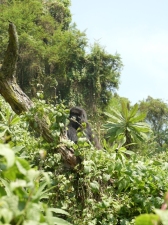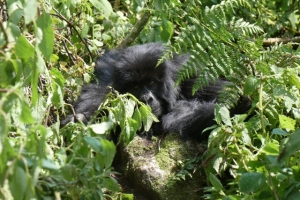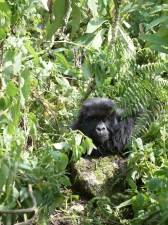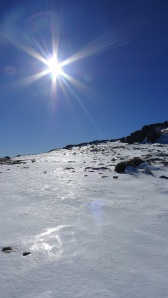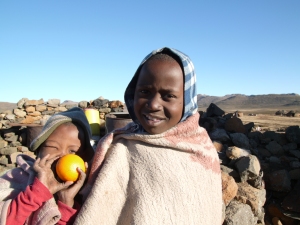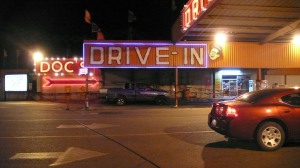Snap, crackle, silence. Peering around the corner, as promised a fuzzy black ball appeared, walking away from our group. Our experienced guide Edward motioned for us all to slowly crawl forward. The gorilla pauses and turns around to face us, two big brown gorilla eyes peeping out of the dense green foliage. After a quick glimpse she sighs, looked at her meal, and continuing to munch away at some leafy delicacy that she had found before our motley group of muzungus interrupted her meal.
Gorilla families tend to stay close by one another, and our trackers motions for us to continue on to see the rest of the family, which includes a nursing mother and her youngster, and another female with two more babies. We patiently follow the troupe, sometimes sliding down the trails that they make with their massive, 300-500 pound bodies, to quietly observe their behavior in the wild.
I can hardly believe that after 25 years, I am face to face with a silverback gorilla and his baby. 25 years since first watching Jane Goodall woo the chimps on National Geographic, dreaming of interacting with primates in their natural homes, we had hiked for just a few hours into the Virunga mountains and here were these beautiful, gentle creatures right before us. The silverback just three feet in front of me was totally ignoring me as he leads his group onto the most delectable foliage he could find, while the mothers give us (passive) glances.
The babies, they are the most curious, and those whom we are able to watch for the longest time. The baby looks back, curiously and confidently, from within the cradle of the mother’s arms.
Edward, who had taken Natalie Portman and Kristin Davis to trek gorillas in the past, tells us that we have just five minutes left with the group. These last few moments are just delightful. One baby climbs onto the back of his father, the great silverback, and puts on quite a display for us. He lounges casually in one moment, stands up to stretch in another… and even gives us a mini chest-beat, copying his father’s protective behavior, as he stares right at us 6 outsiders.
In Gorillas in the Mist, Dian Fossey writes about her internal struggle with having habituated the mountain gorillas to learn more about their behavior. She feared that habituating them to humans would make them more vulnerable to poachers, and that tourists would not respect and revere the animals in the wild. I can only thank her from the bottom of my very full heart that day in the Virungas, for both the humanity that I felt as my eyes locked with a wild mountain gorilla, but also for contributing to the sustainability and survival of the species.
For each $500 permit that is purchased to see a gorilla (and there are 56 allowed per day, netting USD$28,000/day), funds are contributed for the conservation of the park, vets for sick gorillas, 6 trackers per group to record their behavior and whereabouts, anti-poaching patrols, and community development projects with the Rwandans who live off of subsistence farming around the park. There are now over 400 mountain gorillas on the Rwandan side of the border, whereas Fossey had counted 200+ when she started her work in the late 1960’s. It’s an incredible source of income and pride for this healing country, and seems to be a genuine model of conservation of the people and creatures that live in and around the Virungas.
